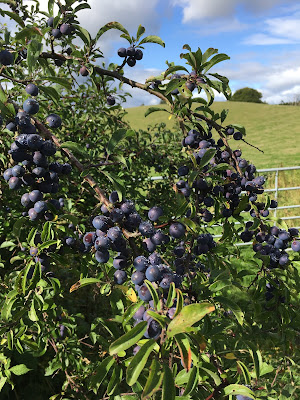It’s said that Life is to be found ‘at the edges’… whether
it is a conglomeration of organisms around a thermal vent in the deep ocean or
our ancestors settling in coastal communities, foraging between the low tide
line and the woods beyond the beach. More prosaically, and with a
slightly-intended pun, this is also true of hedges. As a boundary between
fields, or between a pasture and a path, or even bordering woodland, these are
all edges in some sense.
In Orkney, it’s not a habitat which we come across very
often, but when we do, it’s to be savoured. So when on holiday, we often seek
out such places for the biodiverse havens that they are. And at this time of
year, at least the other week in Perthshire, ‘this time of year’ means mellow
fruitfulness.
On one of our walks over the Hill of Alyth, we ventured
along between two such hedges, and although many of the Summer-visiting birds had
departed, there was still plenty to experience.
I can’t recall ever, anywhere, seeing such a profusion of
sloes adorning a Blackthorn. Whether this is due to the previous very cold
Winter and the hot, dry Summer, I don’t know. Perhaps this quiet corner of
Scotland is always so sloe.
There were also masses of hips and haws on the wild roses and hawthorns, as well as plenty of blackberries on the bramble bushes. I have to admit, I had
committed the error of not packing my blackberrying stick (the one with a coat
hook on the end) when making holiday preparations. Truth be told, it’s not had
much use in Orkney, but we lamented its absence now as we walked by bush after bush
of forageable fodder.
 |
| Muscid Fly on a Rosa rugosa hip |
 |
| Comma butterfly |
Over lunch in a café in Alyth, as we dripped dry from a
sudden heavy shower, we mused upon our brambling options. Do we pass up on free
food for lack of a suitable container to carry them in? Do we nip into the local
Co-op and purchase a plastic container with a lid? Or do we womble a discarded,
single use, plastic bottle from the grass verge and give it a second, and very
environmentally-friendly, use? Oh, I should think so!
Fortuitously, we had brought some apples from Orkney, rather
than leave them to moulder at home, or chuck them away. We had already bought
porridge oats for our breakfasts and a tub of margarine for toast, so there was the
beginning of a crumble. By carefully searching out every sachet of sugar in the
cottage, I was able to complete the deal, and soon was gazing impatiently and
hungrily through the oven door.
 |
| Yum |
Yew berries are poisonous to humans, but one tree in the
grounds of the estate was being jealously guarded by a family of Mistle
Thrushes, whose rattling calls could be heard whenever they thought anyone else
had the temerity to even think of pinching a berry. This Red Admiral was quite
well camouflaged though, escaping the birds’ attention, as it sipped from some fruity
sweetness. I presumed the upside down tactic was to improve the angle for
suction rather than because the insect was paralytic on fermented berry juice?
Whilst in the well-maintained gardens of Glamis Castle, I
noticed an odd thing. It was a cool, cloudy morning, and the bumblebees and
hoverflies were not very active. Many were heads down in the plentiful Sedum
blooms, waiting for a blast of sunshine to kick start their flights, but
passing the time by mainlining nectar.
This wasn’t the odd thing. No, the
mystery was that there were only two individual plants, both of the same
species, which were being visited by wasps. These were Persicarias which had
some unknown (to me) attraction for the wasps, as they studiously ignored all
the other blooms and were only to be found clambering around the dark red spikes.
 |
| Common Wasp on Persicaria |
Also in the gardens at Glamis, I was heartened to find a small Fumitory plant, tucked away beneath a shrub. I always approve of a varied selection of arable weeds in a garden!







No comments:
Post a Comment